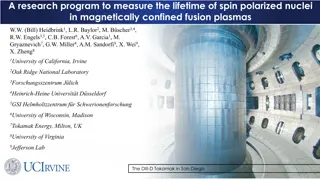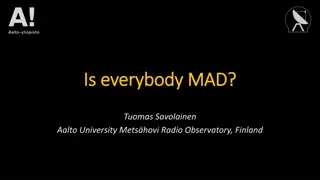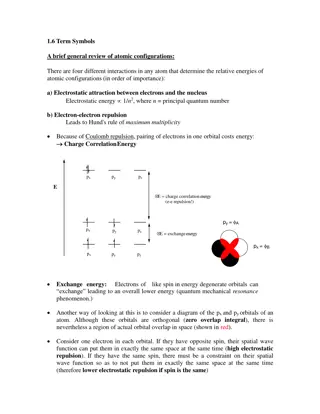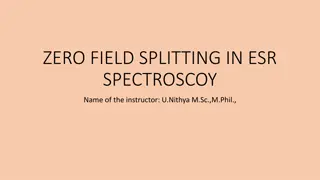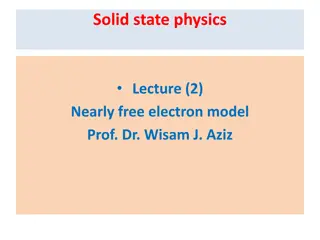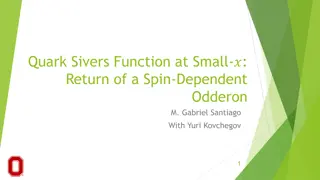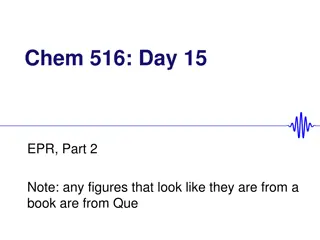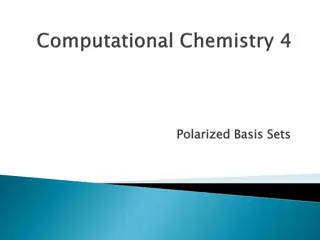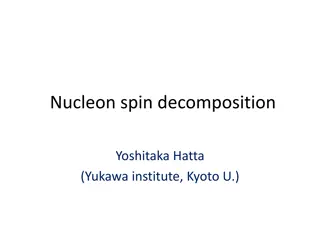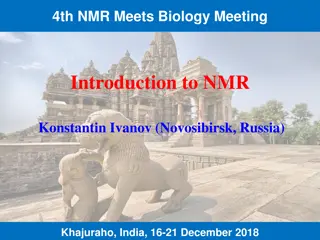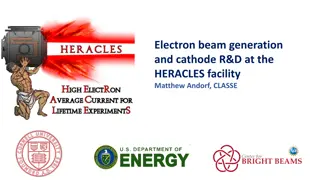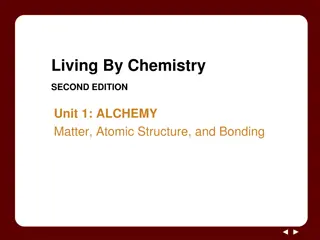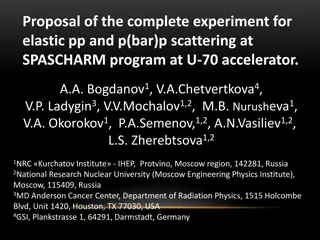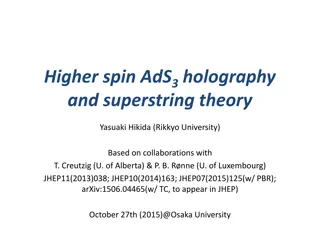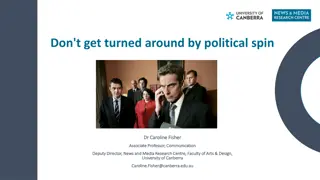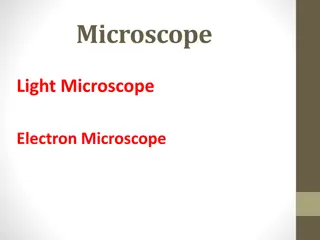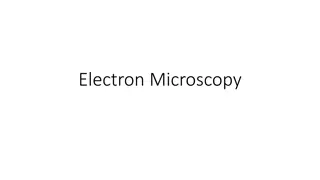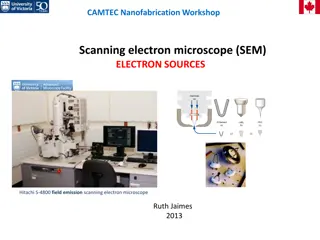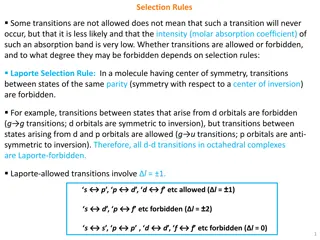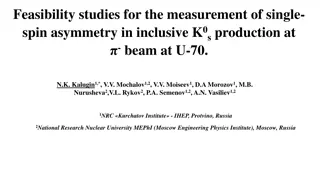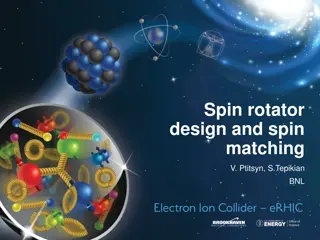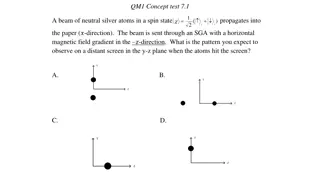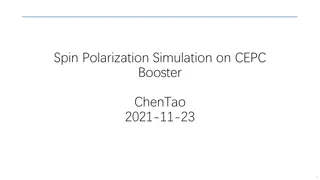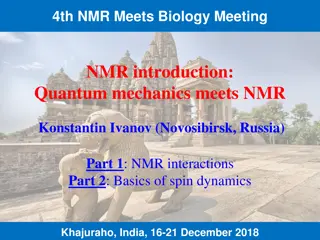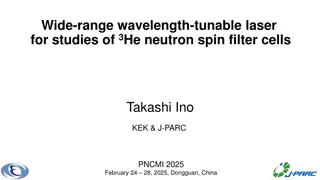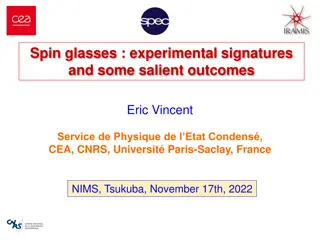Research Program on Spin Polarized Nuclei in Fusion Plasmas
Examination of spin polarized fuel in fusion plasmas to enhance energy production efficiency. Planned experiments aim to measure the lifetime of polarized nuclei for optimized fusion reactions. Key aspects include depolarization mechanisms, neutral beam heating, and fueling techniques with pellets.
2 views • 36 slides
AGN Jet Production Efficiency: Insights from Spin and Magnetic Flux
A fundamental question in astrophysics is how efficiently active galactic nuclei (AGN) produce jets. Black hole spin and magnetic flux play crucial roles in determining the jet production efficiency. High-spin values and large magnetic flux threading are essential for generating high-efficiency jets
2 views • 22 slides
Atomic Configurations and Term Symbols
The energy of atomic configurations is determined by electrostatic attraction between electrons and the nucleus, electron-electron repulsion, spin-orbit coupling, and spin-spin interactions. Term symbols in electronic spectroscopy specify atomic states using quantum numbers. Hund's rule and the Paul
8 views • 12 slides
Advanced Microbunched Electron Cooling for EIC Design Overview
Microbunched electron cooling is a cutting-edge technique proposed for the Electron-Ion Collider (EIC) design, aimed at enhancing beam properties through coherent electron interactions. The concept utilizes Coherent Electron Cooling (CeC) and broad-band amplification in the form of Micro-bunched Ele
1 views • 16 slides
Crystal Field Theory in Chemistry
Crystal Field Theory (CFT) explains how electron orbital degeneracies, particularly d or f orbitals, are affected by a static electric field generated by neighboring anions. In CFT, the metal ion is considered positive while ligands are negative charges, leading to attractive and repulsive forces af
0 views • 13 slides
Zero Field Splitting in ESR Spectroscopy
Zero field splitting in ESR spectroscopy involves the relaxation times in ESR and how spin-lattice relaxation affects the spectral width. Discover how T1 value and spin lattice relaxation play a crucial role in observing sharp spectrum lines in EPR. Learn about line widths in ESR, spin dilution, and
2 views • 21 slides
Free Electron and Nearly Free Electron Models in Solid State Physics
The Free Electron Model postulates that electrons in metals move freely without interacting with crystal ions, yielding insights on conductivities. Developed by Arnold Sommerfeld, it combines the Drude model with quantum mechanics. Conversely, the Nearly Free Electron Model leans on quantum mechanic
2 views • 22 slides
Quantum Mechanics in Atomic Structure
Exploring the connection between quantum mechanics and the fundamental elements of the periodic table, this material delves into the Schrödinger equation, quantization of angular momentum and electron spin, and the implications on atomic structure. The content covers writing the Schrödinger equati
3 views • 32 slides
30 minute spin workout
Stress management is essential for overall health. Regular physical activity, especially high-intensity workouts like spin classes, is known to reduce stress levels. A 30 Minute Spin Workout provides a concentrated burst of exercise that stimulates t
3 views • 6 slides
Quark Sivers Function and Spin-Dependent Odderon
Quark Sivers function, a key aspect in quantum chromodynamics, plays a role in capturing orbital angular momentum and spin-orbit coupling. Spin-dependent Odderon, an elusive three-gluon exchange, contributes to cross sections in high-energy collisions. Small-$? TMDs from polarized Wilson lines provi
0 views • 17 slides
Electron Paramagnetic Resonance (EPR) and Molecular Symmetry
The discussion covers the relevance and applications of EPR spectroscopy in studying electron behavior, spin-orbit coupling effects, and molecular symmetry. Key concepts include anisotropy, nuclear spin coupling, and deviations in electron g-factors. It delves into how these factors impact the obser
0 views • 11 slides
Electron Correlation and Basis Sets in Molecular Calculations
Polarized basis sets describe the electron density polarization in atoms and molecules to improve accuracy in computed geometries and frequencies. Diffuse basis sets are recommended for calculating electron and proton affinities. Electron correlations account for electron interactions in molecular c
1 views • 8 slides
Fidget Spinners: Science Lesson on Spin Time and Averages
Uncover the fascinating world of fidget spinners with a science lesson on spin time measurement techniques, calculating averages, and factors influencing spin time. Dive into hands-on activities, investigations, and discussions on materials used, bearing types, and spinner weights.
0 views • 28 slides
Nucleon Spin Decomposition and Proton Spin Problem
Explore the complex realm of nucleon spin decomposition and the enigmatic proton spin problem, delving into concepts like orbital angular momentum, quarks and gluons' helicity, and longitudinal double spin asymmetry in polarized deep inelastic scattering. Learn about the spin crisis, gluon polarizat
0 views • 26 slides
Spin Magnetism in NMR: An Introduction to Angular Momentum and Magnetic Moments
Delve into the world of spin magnetism in NMR as we explore the concepts of angular momentum, magnetic moments, Stern-Gerlach experiments, and the quantization of spin. Learn about spin projections, spin relaxation, and the relationship between spin particles and external magnetic fields.
1 views • 34 slides
Electron Beam Generation and Cathode Research at HERACLES Facility
Research at the HERACLES facility focuses on electron beam generation and cathode development for high-current applications. Photocathodes play a crucial role in providing low energy spread beams required for processes like FEL-lasing. GaAs emerges as a promising candidate for spin-polarized electro
2 views • 33 slides
Electron Configurations and the Periodic Table in Chemistry
Explore the world of electron configurations in atoms, subshells, and electron arrangement using the periodic table. Learn about the organization of electrons in subshells, different ways to represent electron arrangements, and how to determine electron configurations based on the periodic table. Di
1 views • 12 slides
Investigation of Spin Observables in Elastic pp and p(bar)p Scattering at SPASCHARM Program
Measurements of spin observables in elastic pp and p(bar)p scattering at 16 GeV will be conducted at the SPASCHARM program using a unique setup with polarized proton and antiproton beams. The experiment aims to extend the energy range for spin studies and compare elastic scattering in pp and p(bar)p
0 views • 24 slides
Higher Spin AdS3 Holography and Superstring Theory
Delve into the fascinating world of higher spin gauge theory, Vasiliev theory, and their applications in AdS/CFT correspondence. Discover the complexity and tractability of higher spin states in superstring theory, as well as the concrete relations between superstrings and higher spin fields in AdS
0 views • 27 slides
Political Spin and Propaganda in Media
Explore the tactics of political spin and propaganda as tools used to shape public perception and manipulate information. Learn about the techniques politicians employ to navigate media dynamics and the covert spin tactics employed in the realm of communication and journalism.
0 views • 10 slides
Microscopes: Light vs. Electron Microscopes
Learn about the differences between light microscopes (LM) and electron microscopes (EM), including their magnification power, resolving power, and key parts. Explore the types of electron microscopes such as Transmission Electron Microscope (TEM) and Scanning Electron Microscope (SEM) for advanced
1 views • 8 slides
Electron Microscopy: A Comprehensive Overview
Electron microscopy (EM) is a powerful technique used in biomedical research to visualize detailed structures of various specimens at high resolution. The process involves an electron gun, electromagnetic lenses, specimen holder, and imaging systems. There are two main types of electron microscopes:
0 views • 12 slides
Scanning Electron Microscopes (SEM) and Electron Sources
Scanning Electron Microscopes (SEMs) utilize focused electron beams to produce high-resolution images by interacting with a sample's electrons. The electron source, such as the electron gun, plays a crucial role in forming fine electron beams for imaging purposes. Different types of electron sources
2 views • 12 slides
Spectroscopic Selection Rules in Transition Metal Complexes
Spectroscopic selection rules govern the intensity and allowed transitions in transition metal complexes, impacting their color and electronic behavior. The Laporte and Spin selection rules play crucial roles, determining the brightness of colors and spin changes during electronic transitions. Vibra
0 views • 9 slides
Feasibility studies for the measurement of single- spin asymmetry in inclusive K
Feasibility studies for measuring single-spin asymmetry in inclusive K0s production at beam at U-70 are discussed, along with SPASCHARM experimental setup details and motivations for single-spin asymmetry measurements at SPASCHARM.
0 views • 17 slides
Spin rotator design and spin matching
In the world of spin rotator design and matching, understanding the intricate interplay between electron energy range and polarization control is key. Explore the innovative solutions and parameter selections that lead to achieving the largest continuous energy range. From electron spin rotators to
0 views • 22 slides
Quark Sivers Function and Spin-Dependent Odderon: Insights from Small-?
Quark Sivers function and spin-dependent Odderon play crucial roles in understanding the three-dimensional structure of hadrons and the asymmetries observed in high-energy scattering processes. Ongoing efforts are focused on determining the small-? asymptotics of these functions and their contributi
0 views • 17 slides
Nuclear Angular Momentum in Atoms: Quantum Numbers and Spin
Explore the quantum numbers and spin related to nuclear angular momentum in atoms, including the principles of electron orbitals, orbital angular momentum, magnetic quantum numbers, and spin concepts. Gain insights into the total angular momentum and nuclear spin in atomic structures.
0 views • 8 slides
Topological Phase Transitions Seminar
This seminar on topological phase transitions, presented by Melda Akyazi, covers topics like XY model, spin wave approximation, vortices, experimental realization, and more. It discusses N-Vector models, Ising model, XY model, Heisenberg model, and the characterisation of phase transitions based on
0 views • 40 slides
Spin Model Checker and Promela Architecture
Delve into the details of Spin Model Checker and Promela system architecture, including SW coverage criteria, scheduling analysis, Spin architecture overview, and components like Tcl GUI. Discover the characteristics of Spin Promela, asynchronous execution, non-determinism, process communication, an
0 views • 25 slides
Quantum Mechanics Concepts: Beam of Neutral Silver Atoms
Explore the behavior of a beam of neutral silver atoms in spin states through various scenarios involving magnetic fields and detectors. Understand the quantum phenomena observed on distant screens and detectors when the atoms interact with magnetic gradients. Delve into the probabilities and prepar
0 views • 8 slides
Understanding Spin Polarization and Depolarization in Particle Accelerators
This simulation explores the generation and transmission of polarized beams in the CEPC accelerator, focusing on maintaining beam polarization in the booster and collider regions. It delves into spin motion in a synchrotron, discussing the preservation of polarization in perfect and real ring scenar
0 views • 13 slides
Insights into Zero-Field Splitting in Electron Paramagnetic Resonance
Explore the intriguing world of zero-field splitting in electron paramagnetic resonance, delving into topics such as spin states, energy levels, and spatial arrangements of electron spins. Discover the energetic consequences of spin orientations and the implications for magnetic properties. Uncover
0 views • 18 slides
Understanding Nuclear Magnetic Resonance (NMR) in Biology: Quantum Mechanics Insights
Explore the fascinating intersection of quantum mechanics and NMR in biology. Delve into topics like Zeeman interaction, spin dynamics, nuclear spin interactions, and angular momentum in NMR. Uncover the complexities of the spin Hamiltonian hypothesis and the g-factor in nuclear spins.
0 views • 64 slides
Tunable Laser for 3He Neutron Spin Filter Cells in Research
Explore the cutting-edge research on a wide-range wavelength-tunable laser for studies involving 3He neutron spin filter cells, presented by Takashi Ino from KEK & J-PARC PNCMI. The laser's purpose, principle, absorption measurements, and conclusions are outlined, alongside motivation and details on
0 views • 29 slides
Understanding Spin Glasses: Experimental Signatures and Outcomes
Explore the intriguing world of spin glasses, including aging effects, memory phenomena, and correlation lengths of spin-glass orders. Discover the theory behind spin glasses, their magnetic properties, and the cluster-glass distinction in this comprehensive study.
0 views • 20 slides
Advances in Free Spin Precession Method by Ivan Koop
Explore the Free Spin Precession Method (FSP) by Ivan Koop, where spins of polarized particles are deflected using an RF flipper to analyze spin rotation and harmonics. Discover the application of RF-Flipper for coherent rotation of spins and the algorithm to calculate effective harmonic values for
0 views • 24 slides
Understanding Spintronics: How Spin Impacts Charge Carriers
Learn about the fascinating world of spintronics and how spin can influence charge carriers, as explained by Tomas Jungwirth from the University of Nottingham Institute of Physics in Prague. Explore the potential of spintronics in various applications such as magnetic field control and writing by cu
0 views • 26 slides
Advanced Application of Electron Microscopes in Microbiology
Explore the advanced technology of electron microscopes by Dr. Nelson Xess at Bhanupratap Deo Govt. P.G. College in Chhattisgarh. Learn about the powerful imaging capabilities and applications of Transmission Electron Microscopes (TEM) and Scanning Electron Microscopes (SEM) in studying minute struc
0 views • 10 slides
How to Become a Spin-Off of Politecnico di Milano
Learn the requirements and procedure to establish a spin-off company associated with Politecnico di Milano, including staff promotion criteria, intellectual property handling, product development, innovation focus, reputation considerations, and competition limitations. Understand the necessary docu
0 views • 7 slides
